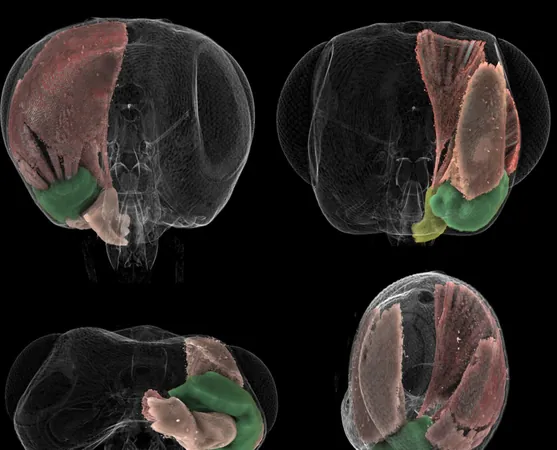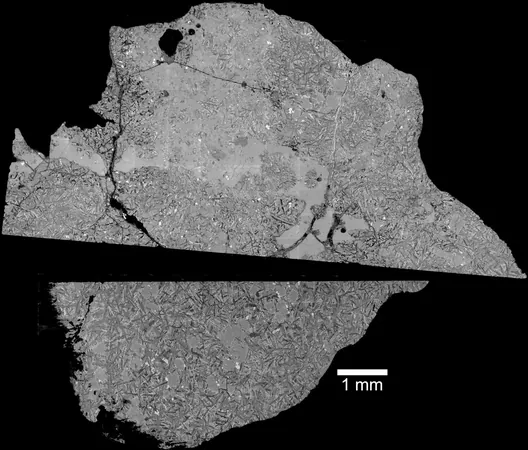
Are Helical Magnetic Fields the Key to Understanding Astrophysical Jets? New Study Reveals Shocking Insights!
2025-01-08
Author: William
Groundbreaking Evidence from the VLA
Recent observations from the Karl G. Jansky Very Large Array (VLA) of the National Science Foundation have unveiled groundbreaking evidence that could change our understanding of astrophysical jets. These jets, which are powerful streams of energy and matter, have mystified scientists for decades, but new research points to a common factor—a helical magnetic field—as the pivotal mechanism driving collimation across different scales, from newborn stars to supermassive black holes.
Key Findings of the Study
Published in The Astrophysical Journal Letters, this study focused on the HH 80-81 protostellar jet and unveiled the presence of helical magnetic fields within it. Remarkably, this structure mirrors those identified in jets emerging from supermassive black holes, suggesting that these scientific phenomena are more interconnected than previously thought.
Importance of Astrophysical Jets
Astrophysical jets are significant because they influence the evolution of their host systems. However, for years, researchers have grappled with how these jets manage to stay confined and avoid dispersing into surrounding space. Adriana Rodríguez-Kamenetzky, the lead researcher from the Institute of Theoretical and Experimental Astronomy, remarked, "This is the first solid evidence that helical magnetic fields can explain astrophysical jets at different scales," bolstering the theory that a universal collimation mechanism exists.
Challenges in Proving Magnetic Fields' Role
While prior research hinted at magnetic fields' role in jet formation, establishing definitive evidence of helical structures in processes like the protostellar jets has proven challenging. The emissions from these jets are generally thermal, making it difficult to trace the underlying magnetic field architecture.
Breakthrough in Research Techniques
Significantly, this new study benefitted from the upgraded capabilities of the VLA. Researchers conducted a meticulous Rotation Measure (RM) analysis of the HH 80-81 jet, a technique that facilitates understanding of the magnetic field by accounting for Faraday rotation—the alteration of light polarization as it travels through magnetized plasma. “For the first time, we were able to study the 3D configuration of the magnetic field in a protostellar jet,” stated Alice Pasetto from the National Autonomous University of Mexico.
Implications of the Findings
The implications of this research are enormous. By successfully applying RM analysis to a protostellar jet, astronomers gained unprecedented insights into its three-dimensional magnetic structure. The findings confirmed that the helical magnetic field is intrinsic to the disk-jet system, rather than a mere artifact of interaction with the surrounding environment.
A Universal Mechanism?
This study's revelations lend robust support to the hypothesis that helical magnetic fields are a universal mechanism for conjoining astrophysical jets, transcending the limits of scale and origin. As scientists deepen their understanding of these magnetic structures, we may be on the cusp of unlocking the mysteries surrounding jet formation and their role in cosmic evolution.
Looking Ahead
With such exciting discoveries on the horizon, one cannot help but wonder: What other secrets of the universe lie hidden in the depths of these astonishing celestial phenomena? Stay tuned!









 Brasil (PT)
Brasil (PT)
 Canada (EN)
Canada (EN)
 Chile (ES)
Chile (ES)
 Česko (CS)
Česko (CS)
 대한민국 (KO)
대한민국 (KO)
 España (ES)
España (ES)
 France (FR)
France (FR)
 Hong Kong (EN)
Hong Kong (EN)
 Italia (IT)
Italia (IT)
 日本 (JA)
日本 (JA)
 Magyarország (HU)
Magyarország (HU)
 Norge (NO)
Norge (NO)
 Polska (PL)
Polska (PL)
 Schweiz (DE)
Schweiz (DE)
 Singapore (EN)
Singapore (EN)
 Sverige (SV)
Sverige (SV)
 Suomi (FI)
Suomi (FI)
 Türkiye (TR)
Türkiye (TR)
 الإمارات العربية المتحدة (AR)
الإمارات العربية المتحدة (AR)